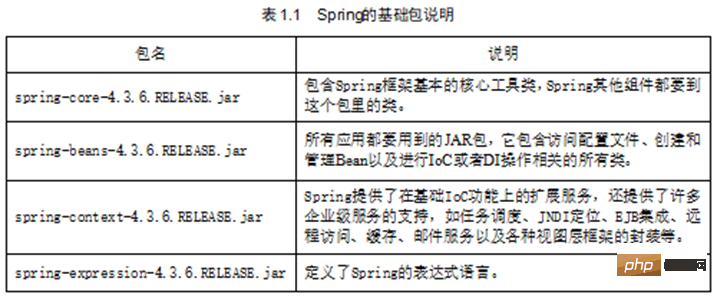Detailed explanation of Spring IOC and DI

What is Spring
Spring is a framework with IoC and AOP as its core.
IoC (Inversion of Control, Inversion of Control) is the foundation of Spring.
IoC simply means that when creating an object, the previous programmer called the new constructor method instead of leaving it to Spring to create the object.
DI (Dependency Inject, dependency injection) has the same meaning as IoC, except that these two names describe the same concept from two perspectives.
Simply put, DI is the attribute of the object. The relevant values have been injected and can be used directly.

IoC-Inversion of Control
After encapsulating each object class, associate these object classes through the IoC container. In this way, objects are connected through the IoC container, and there is no direct connection between objects.

Before the application introduces the IoC container, object A depends on object B. Then when object A is instantiated or runs to a certain point, it must actively create object B or use it. Created object B, whether creating or using the created object B, the control lies with the application itself.
If the application introduces the Ioc container, the direct connection between object A and object B is lost. Therefore, when object A is instantiated and run, if object B is needed, the IoC container will Actively create an object B and inject it (i.e. dependency injection) into the place where object A needs it. As a result, the process of object A becoming dependent on object B changes from active behavior to passive behavior, that is, the creation of the object is handed over to the IoC container for processing, and the control rights are reversed. This is the so-called inversion of control.
DI-Dependency Injection
The IoC container dynamically injects certain dependencies into objects during runtime. For example, inject (assign) object B to a member variable of object A.
In fact, Dependency Injection (DI) and Inversion of Control (IoC) are different descriptions of the same thing. In a certain aspect, they describe it from different perspectives. Dependency injection is described from the perspective of the application, that is, the application relies on the container to create and inject the external resources it needs; while inversion of control is described from the perspective of the container, that is, the container controls the application, and the container reverses the direction of the application. The application injects external resources required by the application. The external resources mentioned here can be external instance objects, external file objects, etc.
IoC and DI implementation
(1) Property setter method injection: refers to the IoC container using the setter method to inject dependent instances. After instantiating a Bean by calling the parameterless constructor or parameterless static factory method, and calling the setter method of the Bean, dependency injection based on the setter method can be implemented. This method is simple, intuitive, and easy to understand, so Spring's settings injection is widely used.
package com.ssm.entry;
public class UserServiceImpl implements UserService {
private UserDao userDao;
// setter()实现依赖注入
public void setUserDao(UserDao userDao){
this.userDao = userDao;
}
public void login() {
this.userDao.login();
System.out.println("UserService login");
}
} (2) Constructor injection: refers to the IoC container using the constructor method to inject dependent instances. Dependency injection based on constructor is implemented by calling the constructor with parameters, each parameter represents a dependency.
applicationContext.xml
<?xml version="1.0" encoding="UTF-8"?>
<beans xmlns="http://www.springframework.org/schema/beans"
xmlns:xsi="http://www.w3.org/2001/XMLSchema-instance"
xsi:schemaLocation="http://www.springframework.org/schema/beans
http://www.springframework.org/schema/beans/spring-beans-4.3.xsd">
<!-- 将指定类配置给Spring,让Spring创建其对象的实例 控制反转 -->
<bean id="UserDao" class="com.ssm.entry.UserDaoImpl"></bean>
<!-- 添加一个id为userService的Bean 依赖注入-->
<bean id="UserService" class="com.ssm.entry.UserServiceImpl">
<!-- 将name为UserDao的Bean注入UserService实例中 -->
<property name="UserDao" ref="UserDao"/>
</bean>
</beans>IoC test
package com.ssm.entry;
import org.springframework.context.ApplicationContext;
import org.springframework.context.support.ClassPathXmlApplicationContext;
public class IoC {
public static void main(String[] args) {
ApplicationContext applicationContext = new ClassPathXmlApplicationContext("applicationContext.xml");
UserDao userDao = (UserDao)applicationContext.getBean("UserDao");
userDao.login();
}
}DI test
package com.ssm.entry;
import org.springframework.context.ApplicationContext;
import org.springframework.context.support.ClassPathXmlApplicationContext;
public class DI {
public static void main(String[] args) {
ApplicationContext applicationContext = new
ClassPathXmlApplicationContext("applicationContext.xml");
UserService userService = (UserService)applicationContext.getBean("UserService");
userService.login();
}
}Recommended tutorial: "Java Tutorial"
The above is the detailed content of Detailed explanation of Spring IOC and DI. For more information, please follow other related articles on the PHP Chinese website!

Hot AI Tools

Undresser.AI Undress
AI-powered app for creating realistic nude photos

AI Clothes Remover
Online AI tool for removing clothes from photos.

Undress AI Tool
Undress images for free

Clothoff.io
AI clothes remover

AI Hentai Generator
Generate AI Hentai for free.

Hot Article

Hot Tools

Notepad++7.3.1
Easy-to-use and free code editor

SublimeText3 Chinese version
Chinese version, very easy to use

Zend Studio 13.0.1
Powerful PHP integrated development environment

Dreamweaver CS6
Visual web development tools

SublimeText3 Mac version
God-level code editing software (SublimeText3)

Hot Topics
 A new programming paradigm, when Spring Boot meets OpenAI
Feb 01, 2024 pm 09:18 PM
A new programming paradigm, when Spring Boot meets OpenAI
Feb 01, 2024 pm 09:18 PM
In 2023, AI technology has become a hot topic and has a huge impact on various industries, especially in the programming field. People are increasingly aware of the importance of AI technology, and the Spring community is no exception. With the continuous advancement of GenAI (General Artificial Intelligence) technology, it has become crucial and urgent to simplify the creation of applications with AI functions. Against this background, "SpringAI" emerged, aiming to simplify the process of developing AI functional applications, making it simple and intuitive and avoiding unnecessary complexity. Through "SpringAI", developers can more easily build applications with AI functions, making them easier to use and operate.
 What are the implementation methods of spring programmatic transactions?
Jan 08, 2024 am 10:23 AM
What are the implementation methods of spring programmatic transactions?
Jan 08, 2024 am 10:23 AM
How to implement spring programmatic transactions: 1. Use TransactionTemplate; 2. Use TransactionCallback and TransactionCallbackWithoutResult; 3. Use Transactional annotations; 4. Use TransactionTemplate in combination with @Transactional; 5. Customize the transaction manager.
 Use Spring Boot and Spring AI to build generative artificial intelligence applications
Apr 28, 2024 am 11:46 AM
Use Spring Boot and Spring AI to build generative artificial intelligence applications
Apr 28, 2024 am 11:46 AM
As an industry leader, Spring+AI provides leading solutions for various industries through its powerful, flexible API and advanced functions. In this topic, we will delve into the application examples of Spring+AI in various fields. Each case will show how Spring+AI meets specific needs, achieves goals, and extends these LESSONSLEARNED to a wider range of applications. I hope this topic can inspire you to understand and utilize the infinite possibilities of Spring+AI more deeply. The Spring framework has a history of more than 20 years in the field of software development, and it has been 10 years since the Spring Boot 1.0 version was released. Now, no one can dispute that Spring
 The differences and connections between Spring Boot and Spring Cloud
Jun 22, 2023 pm 06:25 PM
The differences and connections between Spring Boot and Spring Cloud
Jun 22, 2023 pm 06:25 PM
SpringBoot and SpringCloud are both extensions of Spring Framework that help developers build and deploy microservice applications faster, but they each have different purposes and functions. SpringBoot is a framework for quickly building Java applications, allowing developers to create and deploy Spring-based applications faster. It provides a simple, easy-to-understand way to build stand-alone, executable Spring applications
 Application of IoC and AOP in Java language
Jun 10, 2023 pm 12:10 PM
Application of IoC and AOP in Java language
Jun 10, 2023 pm 12:10 PM
In the Java language, IoC (Inversion of Control) and AOP (AspectOriented Programming) are two very important programming ideas and technologies. Their application can greatly improve the maintainability, scalability and reusability of code, thereby helping developers develop and maintain software systems more efficiently. IoC is an object-oriented design pattern, also known as "Dependency Injection"
 How to set transaction isolation level in Spring
Jan 26, 2024 pm 05:38 PM
How to set transaction isolation level in Spring
Jan 26, 2024 pm 05:38 PM
How to set the transaction isolation level in Spring: 1. Use the @Transactional annotation; 2. Set it in the Spring configuration file; 3. Use PlatformTransactionManager; 4. Set it in the Java configuration class. Detailed introduction: 1. Use the @Transactional annotation, add the @Transactional annotation to the class or method that requires transaction management, and set the isolation level in the attribute; 2. In the Spring configuration file, etc.
 The 7 most commonly used annotations in Spring, the most powerful organization in history!
Jul 26, 2023 pm 04:38 PM
The 7 most commonly used annotations in Spring, the most powerful organization in history!
Jul 26, 2023 pm 04:38 PM
With the update and iteration of technology, Java5.0 began to support annotations. As the leading framework in Java, spring has slowly begun to abandon xml configuration since it was updated to version 2.5, and more annotations are used to control the spring framework.
 Implementation and practice of IOC in Go language: Detailed explanation of inversion of control
Apr 07, 2024 pm 02:33 PM
Implementation and practice of IOC in Go language: Detailed explanation of inversion of control
Apr 07, 2024 pm 02:33 PM
Inversion of control is a design pattern that moves object creation and dependency management from client code to the container, improving code flexibility and testability. The implementation of IOC in Go language can use the wire framework. The specific steps include: defining interfaces, defining types, and using wire functions. By using wire-generated containers, you can gain the advantages of improved testability, flexibility, and simplified configuration.






